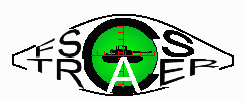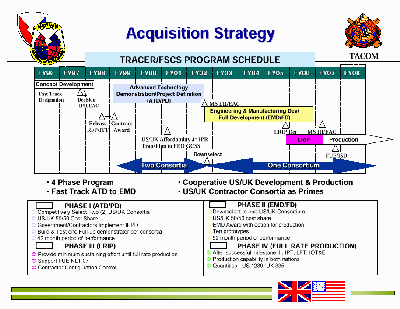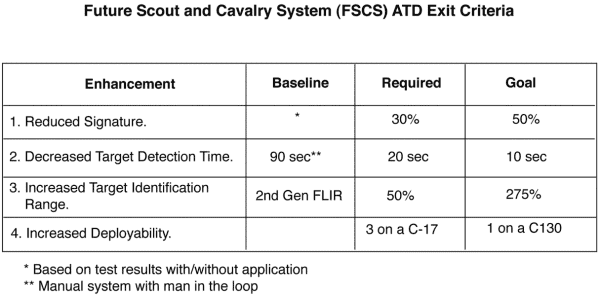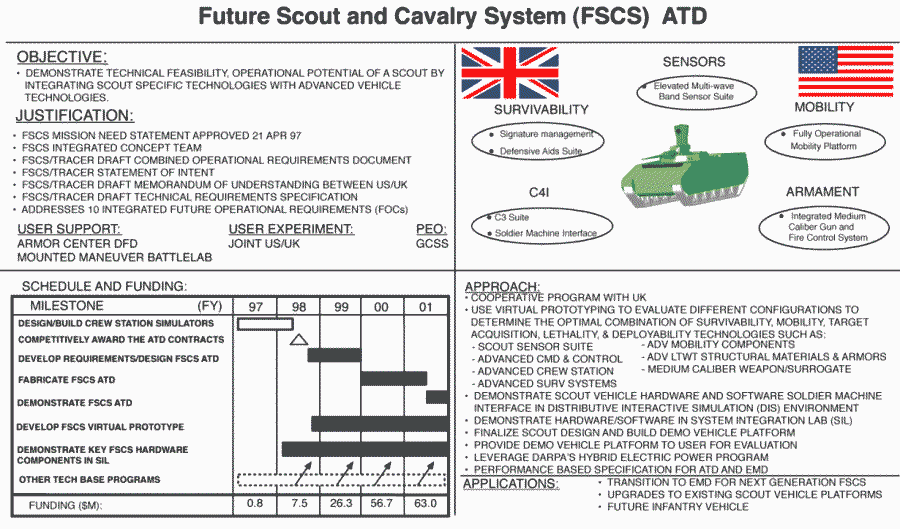
 An 07 July 1998 Memorandum of Understanding (MOU) between the United States and the United Kingdom established the US Future Scout and Cavalry System (FSCS) / UK Tactical Reconnaissance Armoured Combat Equipment Requirement (TRACER) program. FSCS and TRACER are the national program names for a new Armored Scout and Reconnaissance Vehicle (ASRV) as specified in the MOU.
An 07 July 1998 Memorandum of Understanding (MOU) between the United States and the United Kingdom established the US Future Scout and Cavalry System (FSCS) / UK Tactical Reconnaissance Armoured Combat Equipment Requirement (TRACER) program. FSCS and TRACER are the national program names for a new Armored Scout and Reconnaissance Vehicle (ASRV) as specified in the MOU.
The FSCS conceptual system, intended for future scout and cavalry units, features a three-man vehicle crew, mast-mounted sensor package, semi-expendable Micro Aerial Vehicles (miniature UAVs) and Un-manned Ground Vehicles (UGVs) or robots. FSCS would be armed with a notional 40mm gun system for self protection. The sensor package for the FSCS itself and the robots may include both visual and thermal capability. The mast-mounted sensor would be able to elevate to a height of 5 meters to look over intervening terrain or pop-out of tree tops. The MAVs are employed similar to firing a round of ammunition. They would have electro-optical sensors and a limited range (10 kilometers or less) and endurance (approximately 15 minutes). They are intended to provide the scouts a look into the "next valley" capability before moving in a robot or FSCS.
The Future Scout and Cavalry System (FSCS) Advanced Technology Demonstration (1998�01) will demonstrate the feasibility and operational potential of an advanced lightweight vehicle chassis integrating scout�specific and advanced vehicle technologies developed in other technology�based programs. The effort will be fabricated and tested in virtual and real environments to evaluate and validate sensors/situational awareness capabilities and to develop scout tactics. The FSCS ATD will develop and demonstrate scout�specific mobility components such as electric drive, semi�active and fully active suspension, and band track. Other specific technologies that may be integrated into the scout platform include MFS3, advanced lightweight structural materials and armors, advanced crew stations, advanced C2, medium�caliber weapon, and advanced survivability systems. This effort will validate the inherent signature reduction of advanced mobility technologies.
Following 21 months of concentrated activity to set up the co-operative FSCS/TRACER program, the UK signed the Armoured Scout and Reconnaissance Vehicle Memorandum of Understanding on 07 July 1998. The US signed the document on 26 February 1998 but final UK approval was delayed until the UK Strategic Defence Review was concluded. An Invitation to Tender (ITT) for the Advanced Technology Demonstrator / Project Definition (ATD/PD) was issued to Industry on 09 July 1998 with a 75 calendar day tender response period. The MoU itself covers the entire program although much of the detail for successive phases will be negotiated later on and published in supplements to the document. The ITT was issued to two Tenderers: SIKA International, a company formed for the program by Lockheed Martin and British Aerospace; and LANCER, a consortium led by GEC-Marconi. Both consortia comprise a mixture of US and UK companies to enable work to be shared equitably between the industries of both nations. The Joint Project Office (JPO) called for in the MoU is now formally established. It comprises two symmetrical elements, one at the UK�s Procurement Executive in Abbey Wood, Bristol, the other at the US Army�s Tank Automotive and Armaments Command (TACOM) in Warren, Michigan. Technical advice to the JPO is provided by the US Tank Automotive Research Development and Engineering Center (TARDEC) at Warren, supported by other US technical commands, and by the UK Defence Evaluation and Research Agency (DERA).By FY03 the ARDEC Advanced Light Armaments for Combat Vehicles (ALACV) STO will demonstrate 25/35mm ammunitions with 75% or greater improvement in lethality compared to conventional point detonating munitions and 20-40% improvement compared to existing KE & bursting munitions. The ALACV will develop two types of munitions (anti-personnel and anti-armor) to meet the Future Scout and Cavalry System (FSCS) and the Future Infantry Vehicle (FIV) lethality requirements.
The FSCS ATD will fast track in FY02 to the EMD phase of the FSCS program. FSCS is the replacement combat vehicle for the M1114 HMWWV in Armor and Mechanized Infantry Battalion Scout Platoons and the M3A2/3 CFV in Division and Regimental Cavalry Squadrons.
The Fiscal Year 2001 Army budget request included decisions to restructure or "divest" a number of programs in order to provide some of the resources to support its transformation to achieve the ambitious deployment goals outlined in the October 1999 Army Vision. The restructured programs are the Crusader and the Future Scout and Cavalry System. The "divestitures" include Heliborne Prophet (Air), MLRS Smart Tactical Rocket (MSTAR), Stinger Block II, Command and Control Vehicle (C2V), Grizzly, Wolverine, and the Army Tactical Missile System Block IIA. Funding for these programs was reallocated to fund the Army Vision transformation strategy.







